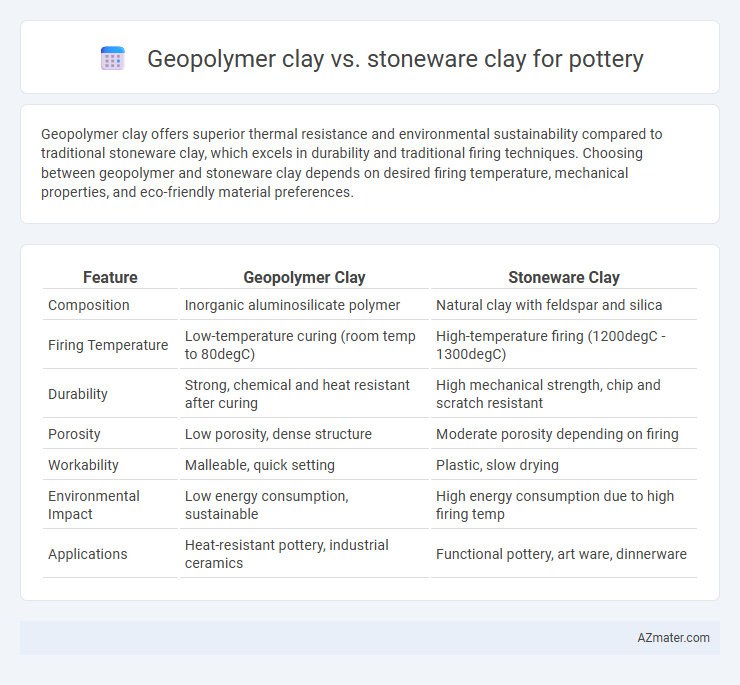Geopolymer clay offers superior thermal resistance and environmental sustainability compared to traditional stoneware clay, which excels in durability and traditional firing techniques. Choosing between geopolymer and stoneware clay depends on desired firing temperature, mechanical properties, and eco-friendly material preferences.
Table of Comparison
| Feature | Geopolymer Clay | Stoneware Clay |
|---|---|---|
| Composition | Inorganic aluminosilicate polymer | Natural clay with feldspar and silica |
| Firing Temperature | Low-temperature curing (room temp to 80degC) | High-temperature firing (1200degC - 1300degC) |
| Durability | Strong, chemical and heat resistant after curing | High mechanical strength, chip and scratch resistant |
| Porosity | Low porosity, dense structure | Moderate porosity depending on firing |
| Workability | Malleable, quick setting | Plastic, slow drying |
| Environmental Impact | Low energy consumption, sustainable | High energy consumption due to high firing temp |
| Applications | Heat-resistant pottery, industrial ceramics | Functional pottery, art ware, dinnerware |
Introduction to Geopolymer Clay and Stoneware Clay
Geopolymer clay is an innovative, eco-friendly material composed of industrial byproducts like fly ash and slag, offering high thermal resistance and durability in pottery. Stoneware clay is a traditional ceramic material known for its strength, plasticity, and ability to vitrify at high temperatures, making it ideal for functional pottery. Comparing these clays highlights geopolymer's rapid curing and sustainability against stoneware's proven workability and finish quality in ceramic arts.
Chemical Composition Differences
Geopolymer clay primarily consists of aluminosilicate materials activated by alkaline solutions, resulting in a synthetic, chemically stable matrix with high silica and alumina content. Stoneware clay contains natural minerals like kaolinite, quartz, and mica, with iron oxide contributing to its firing color and plasticity, forming a vitrified and durable ceramic body upon firing. The key chemical difference lies in geopolymer's engineered inorganic polymer network versus stoneware's naturally occurring silicate minerals, affecting thermal properties and durability.
Physical Properties and Workability
Geopolymer clay exhibits higher compressive strength and improved thermal resistance compared to traditional stoneware clay, making it more durable for functional pottery. Its workability is characterized by a denser consistency and reduced plasticity, which may require greater skill and effort during shaping and molding. Stoneware clay offers better malleability and moisture retention, facilitating easier manipulation and smoother surface finishes for potters.
Firing Temperature and Methods
Geopolymer clay cures at ambient or low temperatures, typically below 200degC, using chemical reactions rather than traditional firing, making it energy-efficient and suitable for low-heat methods like air curing or oven drying. Stoneware clay requires high-temperature firing, usually between 1200degC and 1300degC in a kiln, where vitrification occurs to achieve its strength and durability. The fundamental difference lies in geopolymer clay's cold-setting process versus stoneware's high-temperature vitrification, impacting the final texture and structural properties of the pottery.
Durability and Strength Comparison
Geopolymer clay exhibits superior durability and strength compared to traditional stoneware clay, making it ideal for applications requiring high resistance to mechanical stress and thermal shock. Its inorganic polymer matrix provides enhanced compressive strength and fracture toughness, whereas stoneware clay, though strong, can be more prone to chipping and cracking under extreme conditions. The chemical resistance of geopolymer clay also exceeds that of stoneware, offering longevity in harsh environments and increasing the lifespan of pottery pieces.
Environmental Impact and Sustainability
Geopolymer clay offers a significantly lower environmental impact compared to traditional stoneware clay due to its use of industrial by-products like fly ash and slag, reducing reliance on mined natural clay and minimizing carbon emissions during production. Stoneware clay requires extensive mining, leading to habitat disruption and higher energy consumption for firing at temperatures around 1200degC to 1300degC, whereas geopolymer clay hardens at lower temperatures, conserving energy. Using geopolymer clay promotes sustainability by recycling waste materials and decreasing the pottery industry's carbon footprint, making it a more eco-friendly option for ceramic artists and manufacturers.
Artistic Potential and Aesthetic Qualities
Geopolymer clay offers artists unique possibilities with its ability to mimic natural stone textures and achieve sharp, intricate details, enhancing the aesthetic depth of sculptural pottery. Stoneware clay, known for its rich, earthy tones and smooth finishes, provides a versatile canvas for glazing techniques that emphasize color vibrancy and tactile warmth. Both materials cater to distinct artistic visions, with geopolymer clay excelling in futuristic, textured designs, while stoneware supports traditional, functional beauty.
Cost and Accessibility for Potters
Geopolymer clay offers a cost-effective alternative to traditional stoneware clay, as it typically requires fewer raw materials and less energy-intensive firing processes, reducing overall production expenses for potters. Stoneware clay, while widely available, often demands higher costs due to its natural sourcing, processing, and kiln-firing temperatures, making it less accessible for hobbyists or small-scale artisans. The accessibility of geopolymer clay is enhanced by its synthetic formulation, which can be produced locally or in smaller batches, expanding options for potters in regions with limited access to quality stoneware clay.
Applications in Modern Pottery
Geopolymer clay offers superior heat resistance and durability, making it ideal for functional pottery like cookware and industrial ceramics. Stoneware clay remains favored for traditional pottery due to its plasticity and aesthetic versatility in artistic and decorative pieces. Modern potters increasingly combine both clays to leverage geopolymer's strength with stoneware's workability in innovative mixed-media designs.
Choosing the Right Clay for Your Pottery Project
Geopolymer clay offers key advantages such as high-temperature resistance, durability, and eco-friendly properties compared to traditional stoneware clay, which provides excellent plasticity and ease of shaping for wheel-throwing. Selecting the right clay depends on the project's functional requirements; geopolymer clay suits industrial or sculptural pieces needing strength and weather resistance, while stoneware clay remains ideal for everyday pottery with smoother finishes and food-safe glazing. Understanding these differences ensures optimal performance, from firing behavior to final texture and longevity in pottery creations.

Infographic: Geopolymer clay vs Stoneware clay for Pottery
 azmater.com
azmater.com